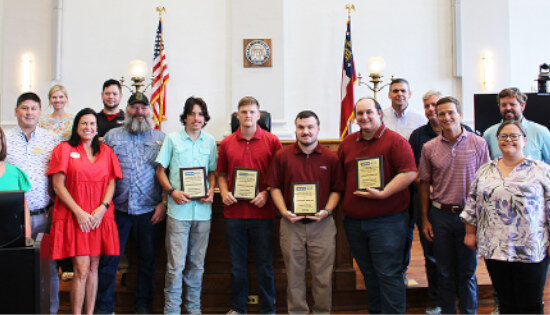Albert Pendleton recalls hearing the cotton mill whistle in Remerton in the morning. “It woke us up and told us when to go to lunch and scared me as a child when my father and I neared the commissary to get a grocery order. It was much louder close up.”
The Strickland Cotton Mill was established in 1899 by B.F. Strickland. Strickland and his brother Lewis were large cotton buyers. A cotton mill was a great investment to the small town since cotton was a main crop and grown in the area.
B.F. reigned as the first president of Strickland Cotton Mill until his death in1915. A.J. Strickland soon became president in 1916-1939 in which his son A.J Jr. took over after his death. Later A. J. III (Bubber) Strickland became president. The founding of the city of Remerton centered around the Strickland Cotton Mill. The site chosen for the mill was named Remerton in honor of Remer Y. Lane. In 1920, up to sixty-five houses had been built around the mill to accommodate mill worker’s commute to the mill, giving way to Mill Village.
In 1930, a 50,000 gallon water tower was built on the east side of the mill that still exists today. Mill village began construction in the 1940’s, with the building of several houses on Victory and Pine Streets.
“The people that lived in Remerton at that time worked in the mill. So that’s how the city of Remerton evolved. We established other businesses within the community. And it just grew from there,”said Mayor Cornelius Holsendolph, Remerton, Ga. “We got a charter in 1951 and it became a chartered city and it has evolved over the years from that time. Come along way from 1951.”
The Strickland mill and village became the incorporated City of Remerton, which allowed for much needed federal and state aid. Directly after Remerton’s incorporation, economic factors caused the Strickland family to slowly lose control of the mill.
The mill’s modest employment of 100 employees; skyrocketed to 600 employees by 1968.
“Normal day, well they were all normal to me. Cause I know how to do it” said Vernell Foster, former employee. “Stand up there to the scale weigh them and put them in the thing. It was easy to me. I liked that Cotton Mill.”
In 1972, operations also began to increase, the mill operated with 22,281 spindles and 574 looms, juxtaposed to its beginning operations of 5,000 spindles and 125 looms. Later that year, the mill upgraded to electricity that allowed for both the mill and village to do away with kerosene lamps.
Unable to compete with other textile manufacturers and foreign competition, the mill announced in January of 1979 that it was closing.
“My brother Odest worked there. That was the first job he ever had, said Barbara Foster, concerned citizen. “But I do know myself when that place closed down. It took Odest about four/ five years to pull himself back up. When you start back over somewhere, your pay may not be the same. Financially, it hurt a lot of people. I think it hurt the whole town.”
Wipo Industries purchased the Strickland Cotton Mill a few years later and renamed it Sugar Creek Textile Mill. Unfortunately, Wipo industries sold the Mill in 1985 to Fred Wilkinson. Wilkinson owned and operated the Mill until November 2005.
In 2012, owners of Mill filed to have it demolished. Meanwhile, Residents rallied and petitioned to preserve the Mill. After a public hearing, the Mill was set to be demolished with smoke stack being kept to form memorial park.
“Well apart of the demo permit was they had to leave the smoke stack and we are creating a passive park. But everything else is going to go,” said Mayor Cornelius Holsendolph, Remerton, Ga. “ Well I don’t think it’ll hurt the history of Remerton. We’re going to leave that portion of the mill there because the rest of it is pretty much dilapidated. The city doesn’t own that property any more. I think once its clear it’ll definitely look better and I think it’ll be easier to sell. I don’t think it got many buyers with those old buildings.”
In June of 2013, demolition of the mill began.
What’s the future going to be, we have no idea said Mayor Cornelius Holsendolph of Remerton.
Photos courtesy of Sally Turner Querin, Erin Ellis, and Valdosta Historical Society and Museum. Story, interviews, and audio by Erin Ellis.





















